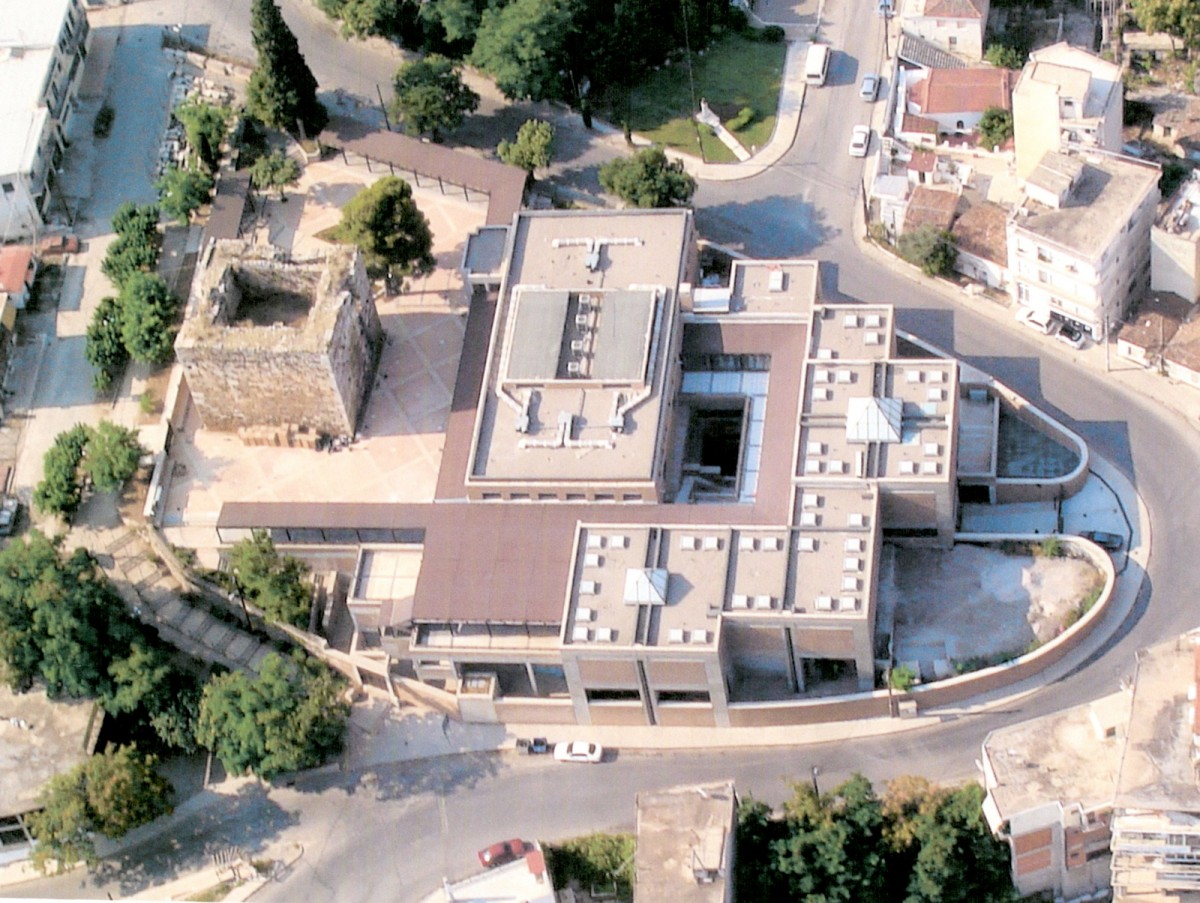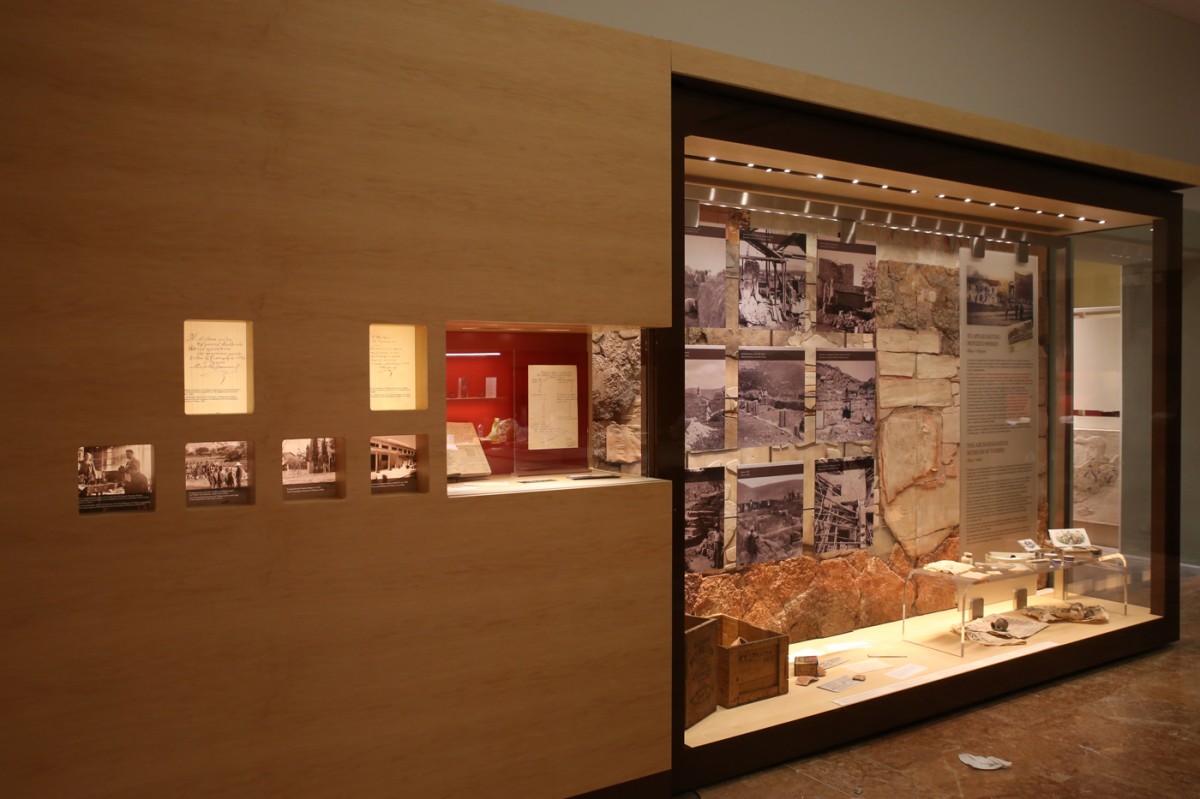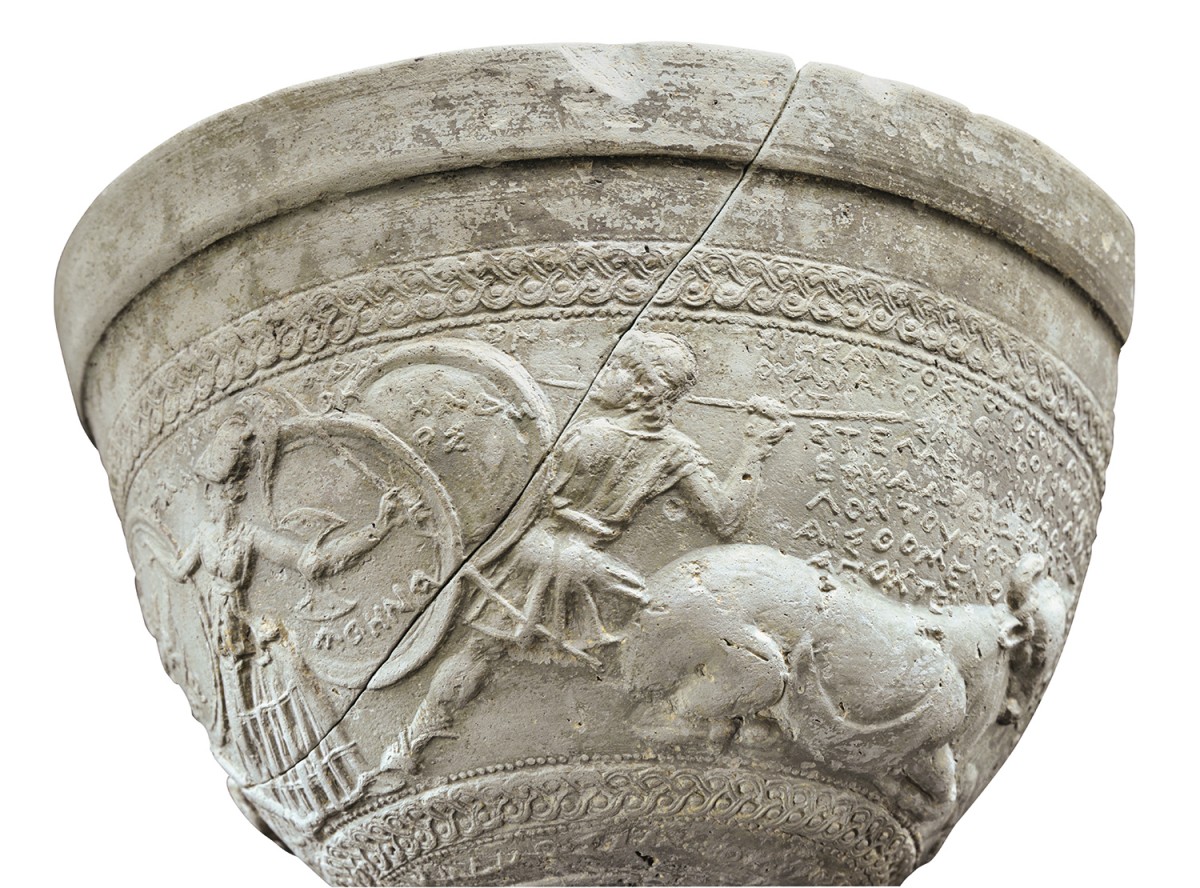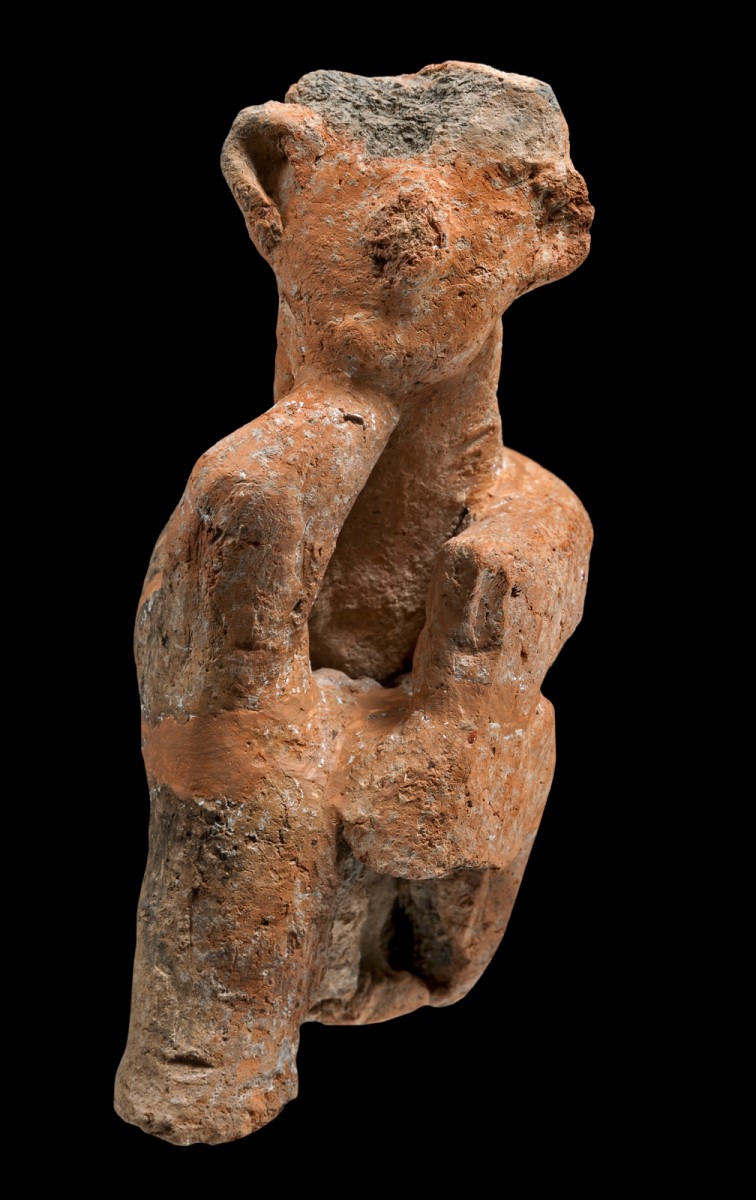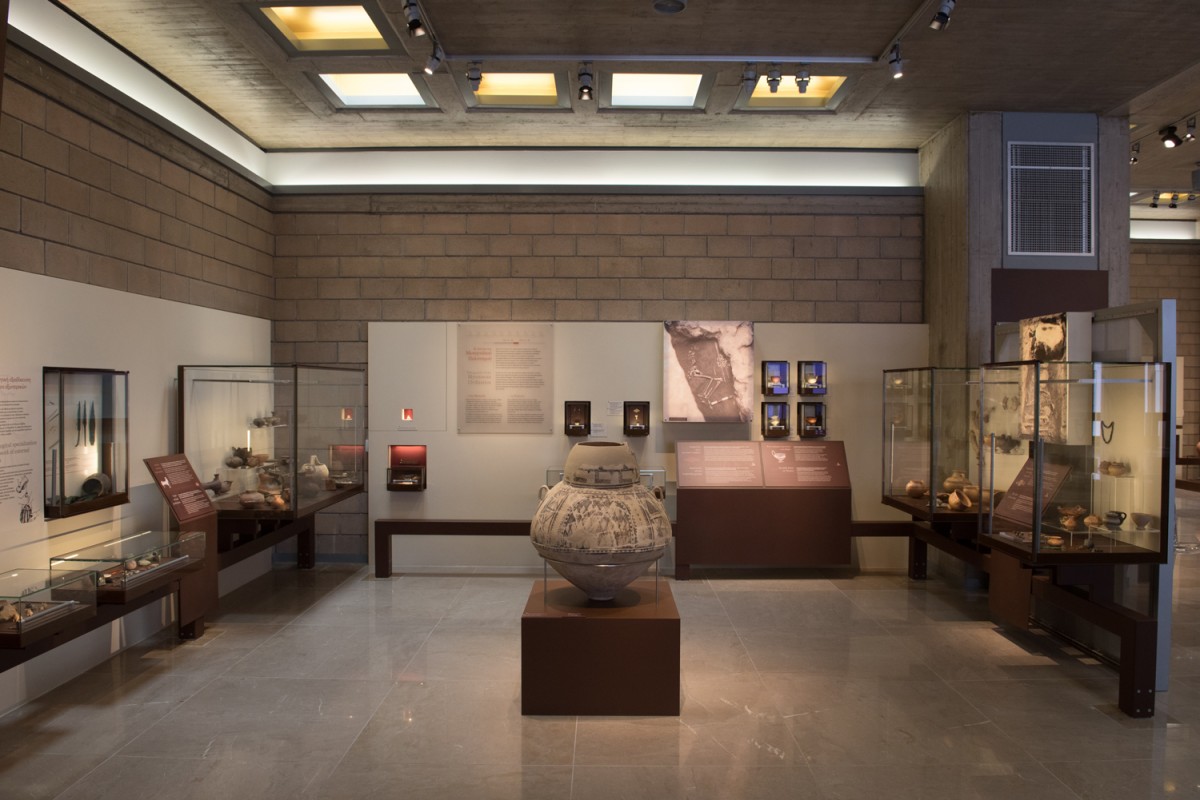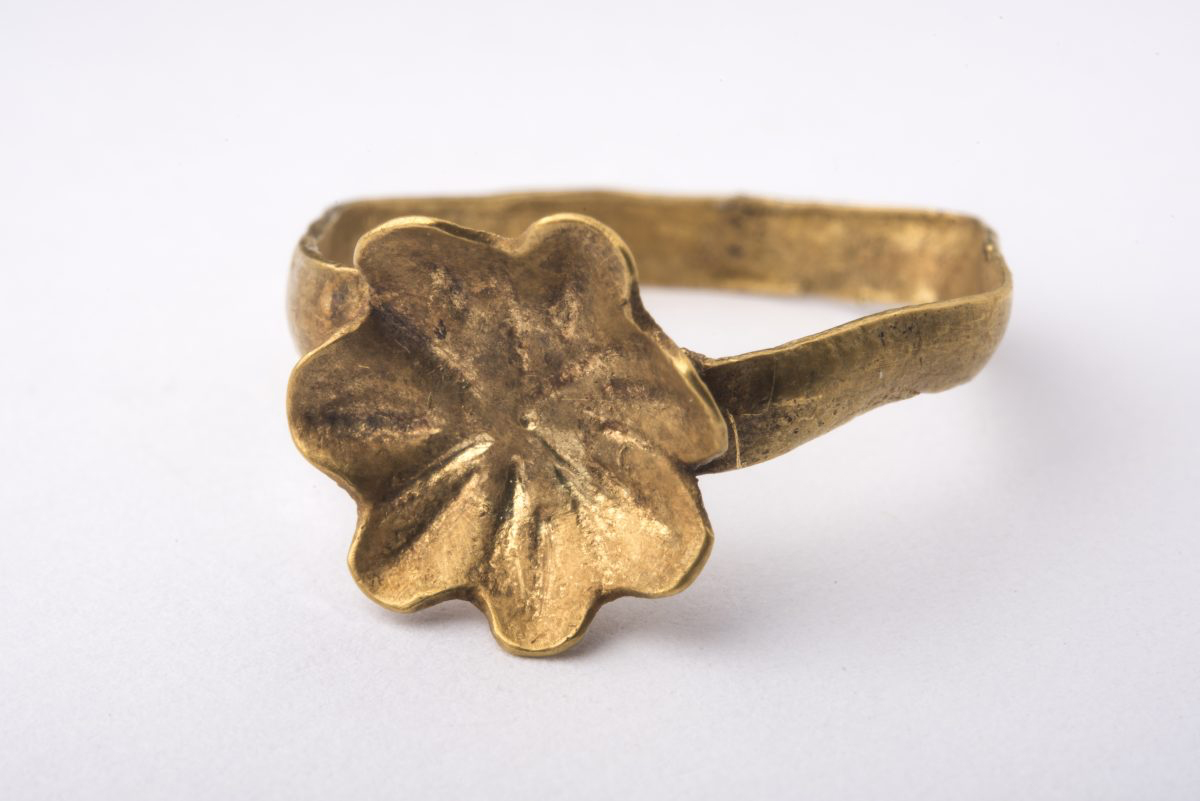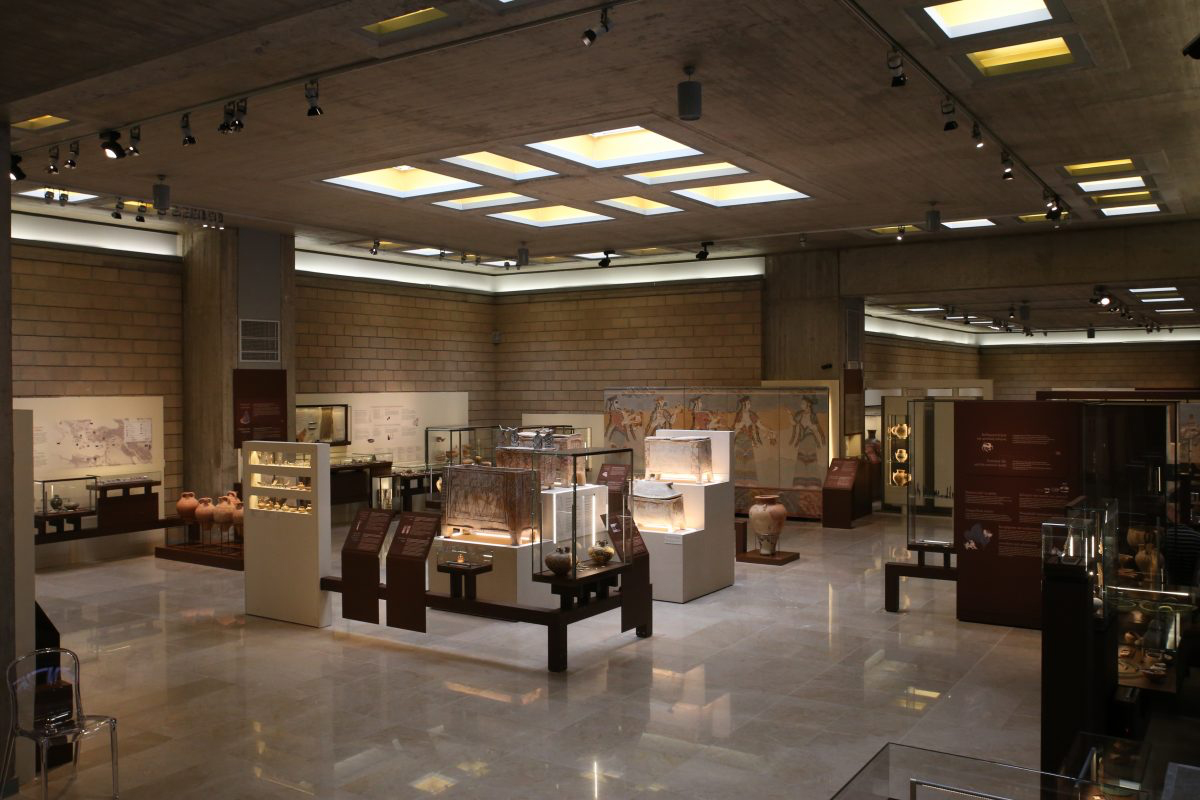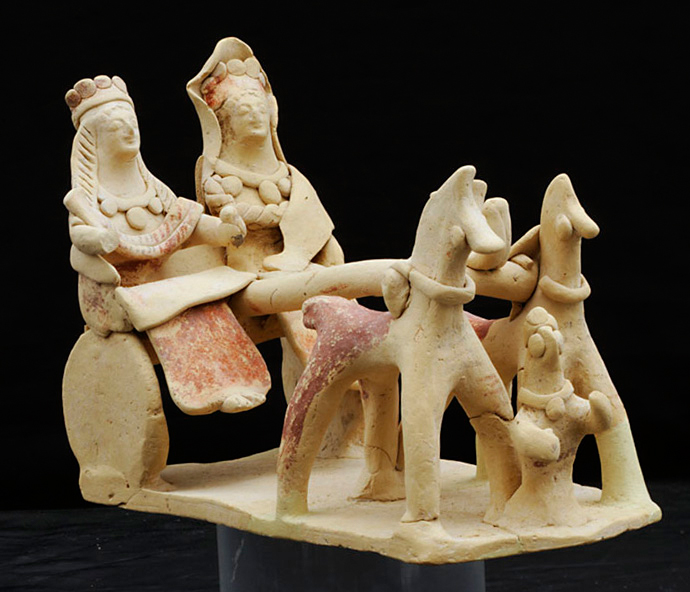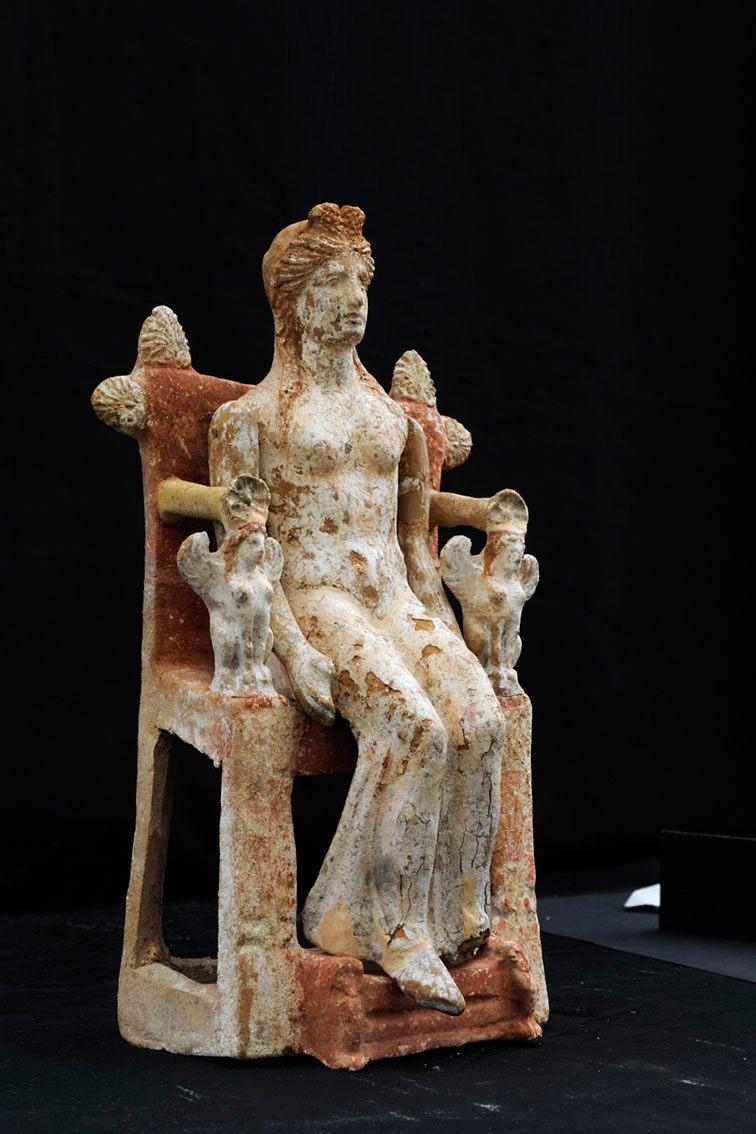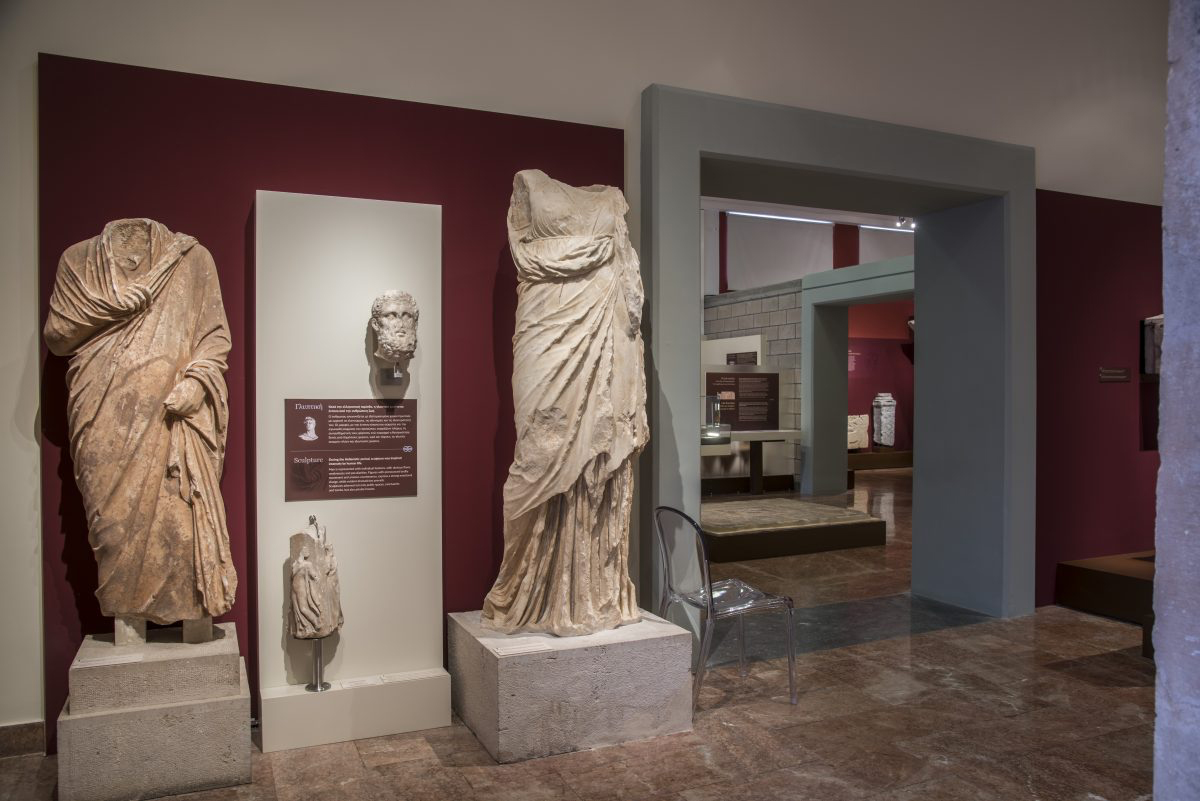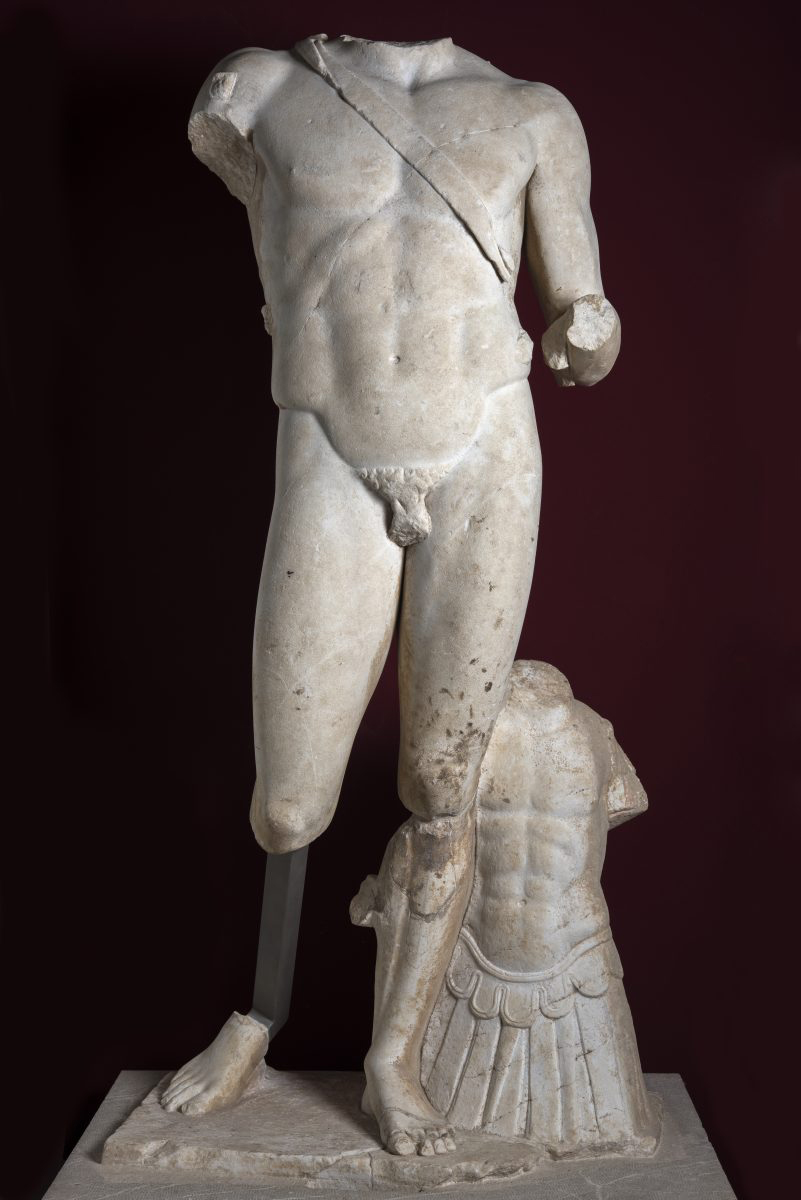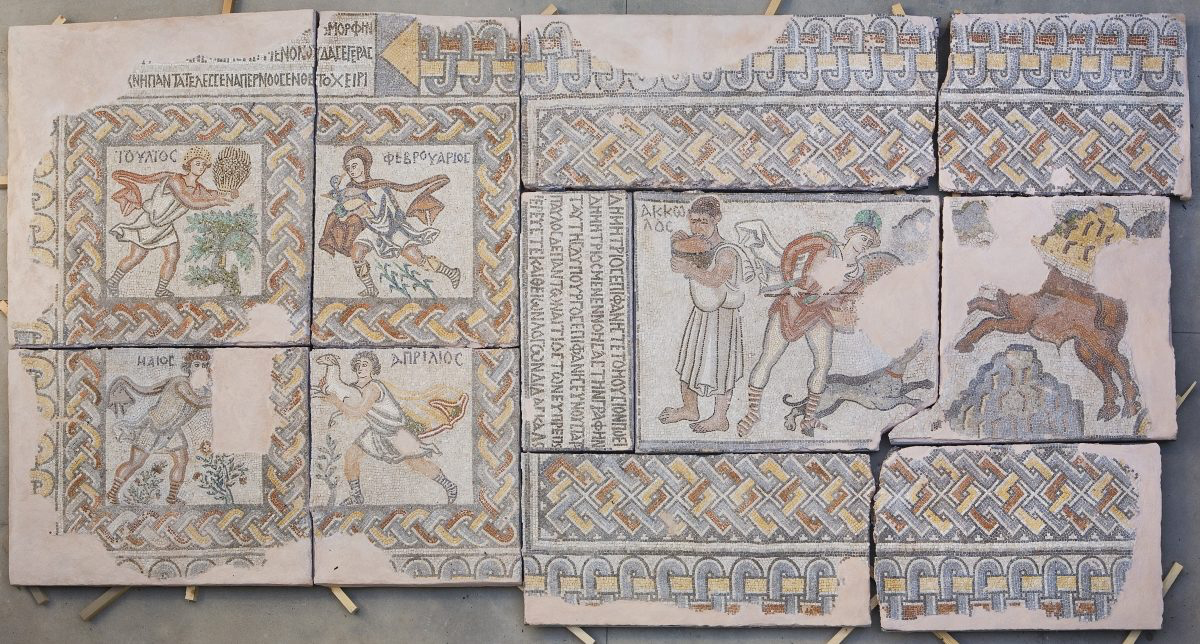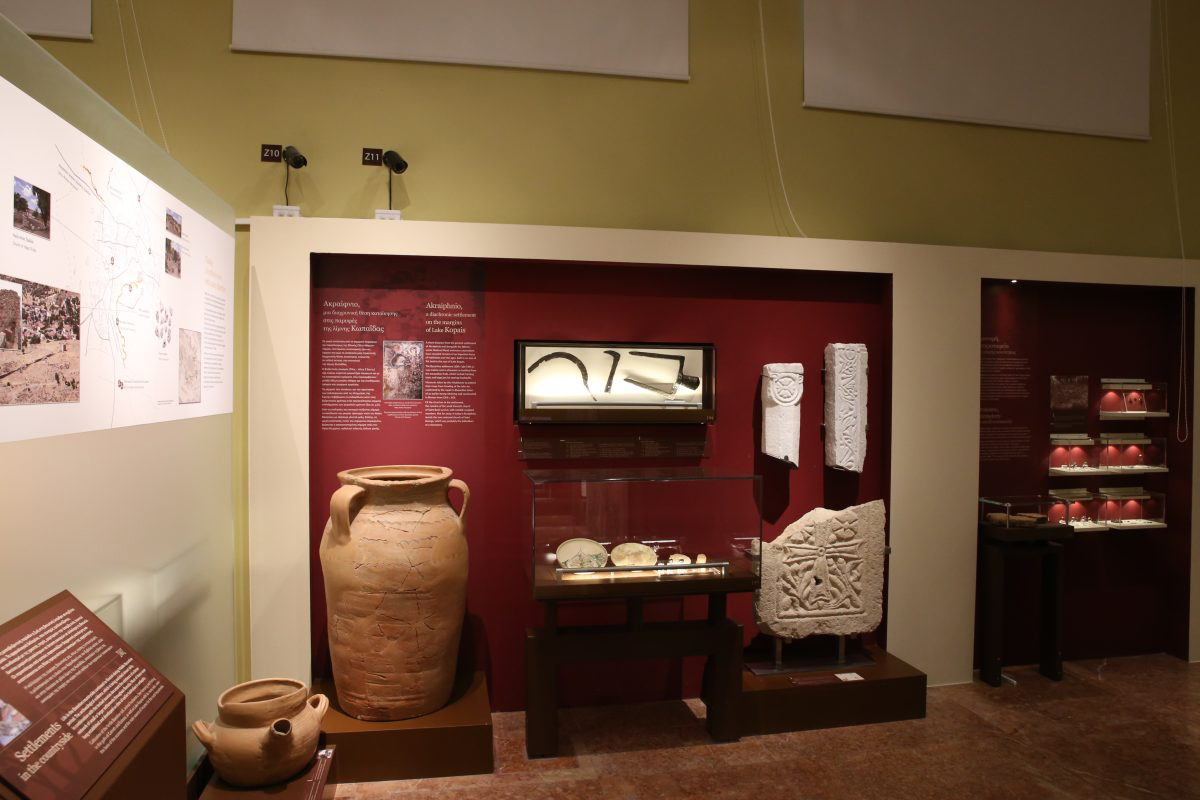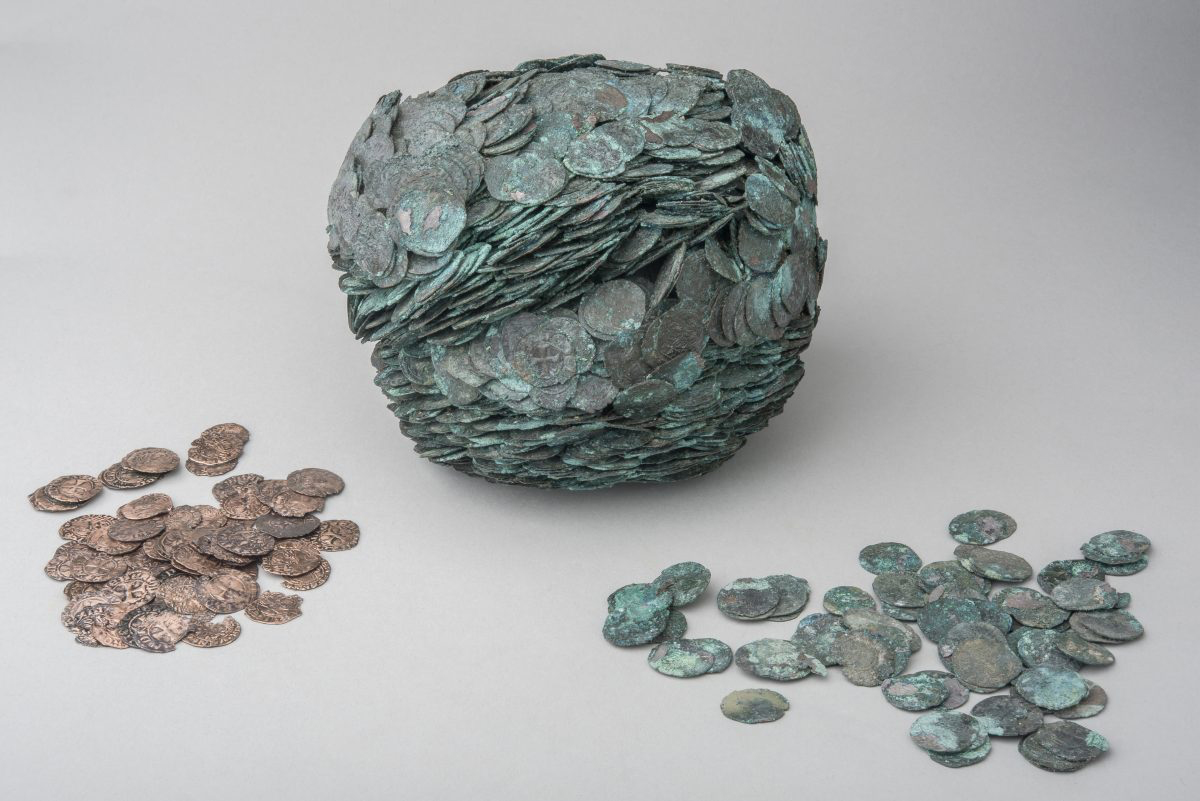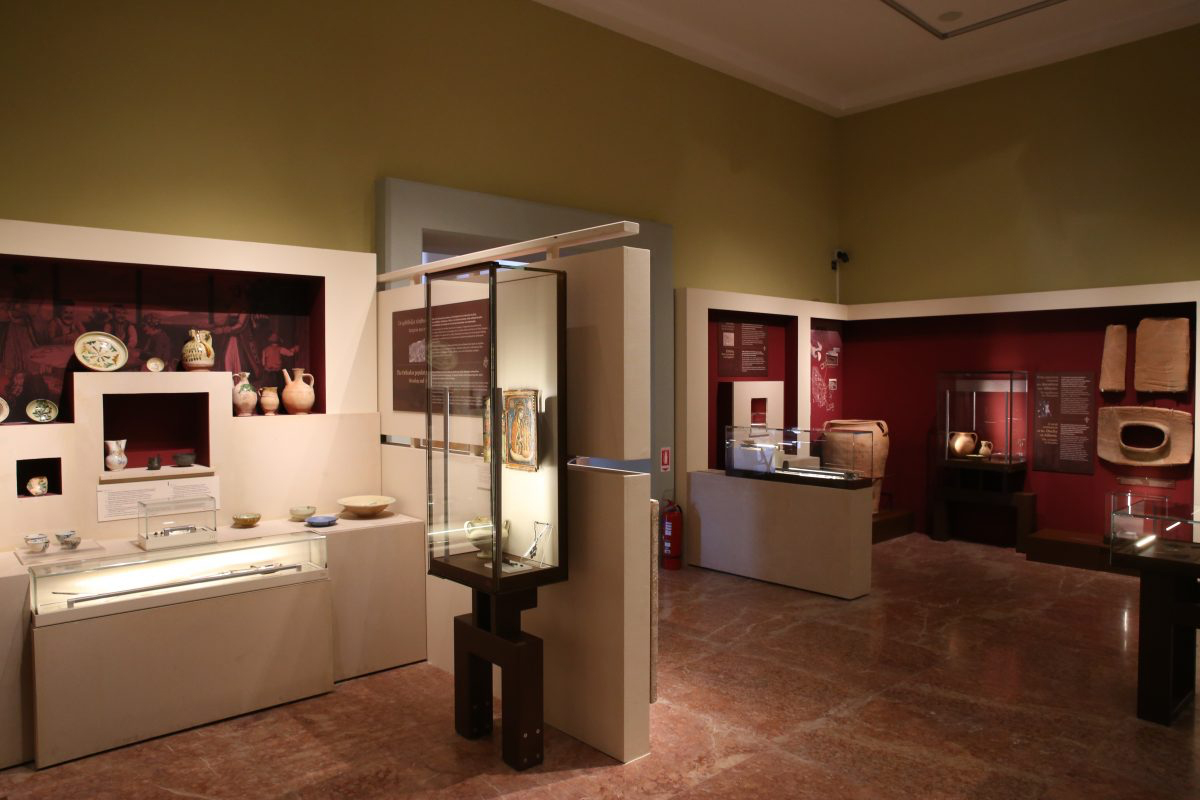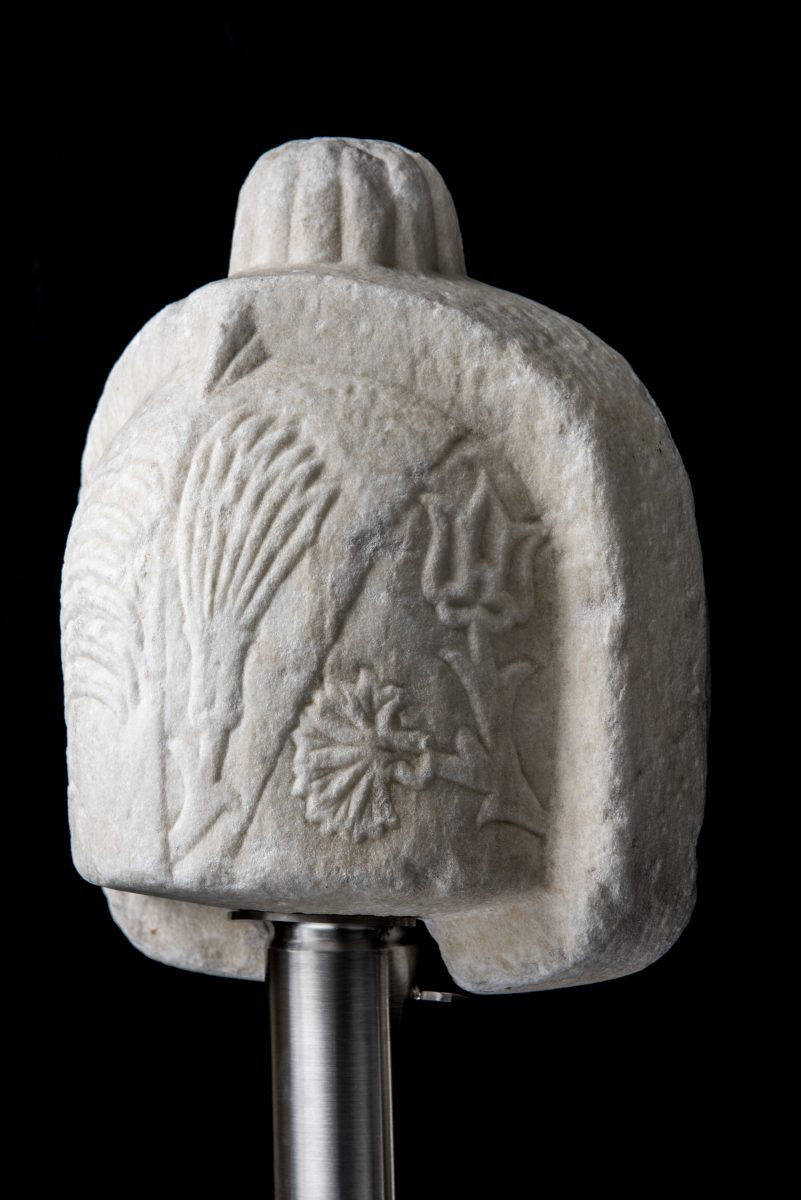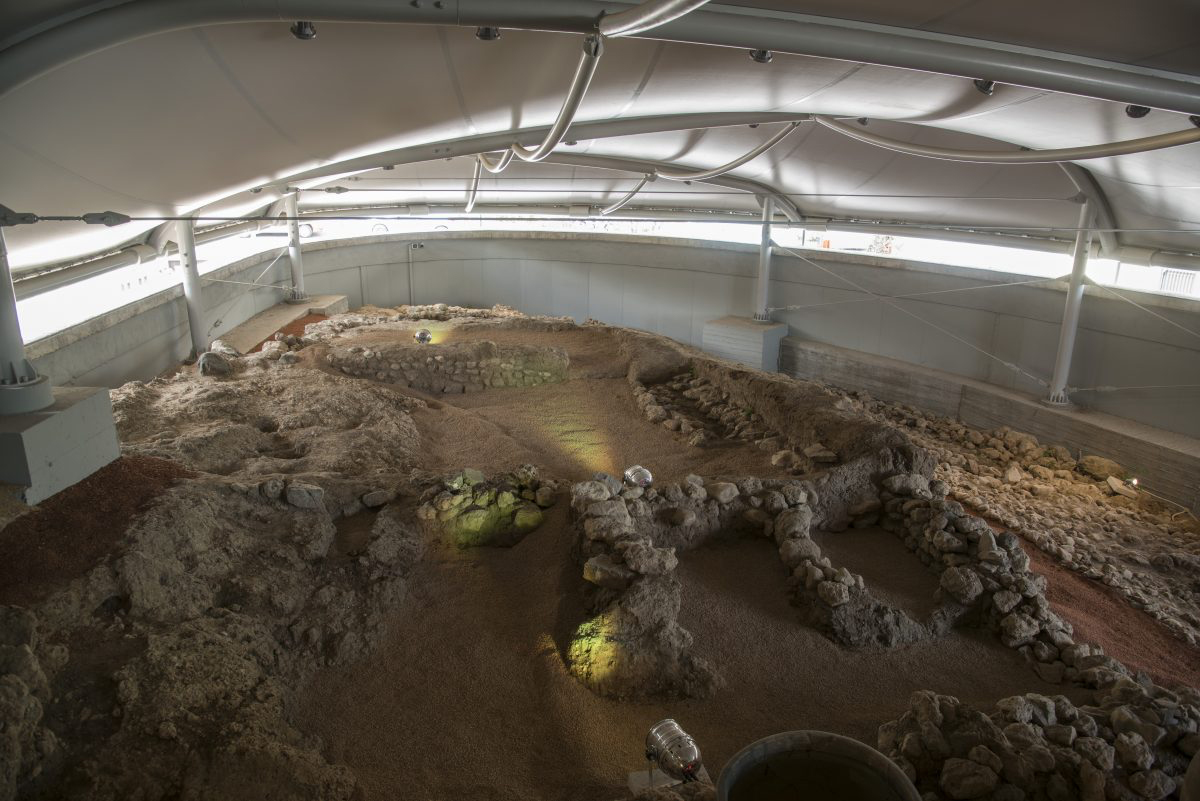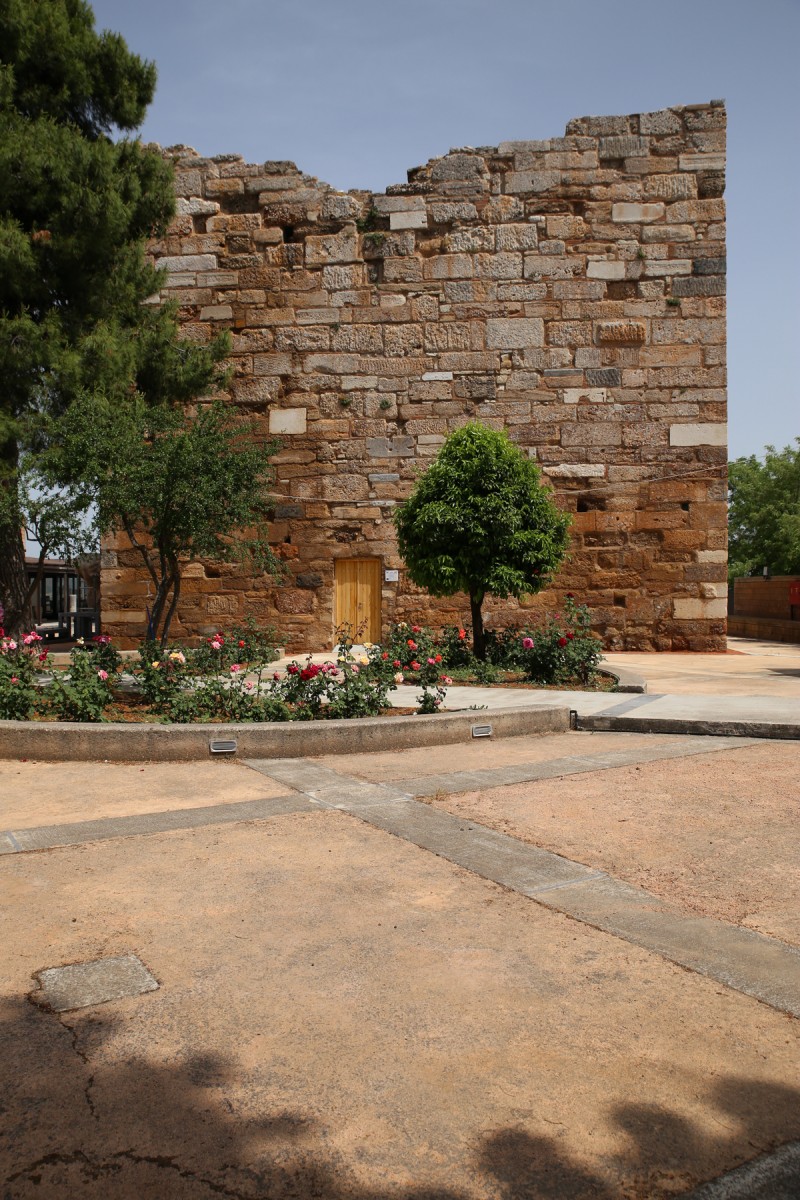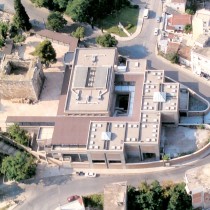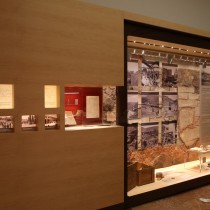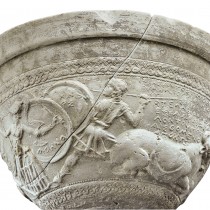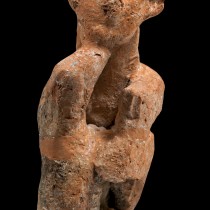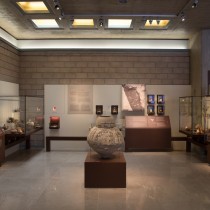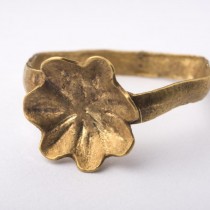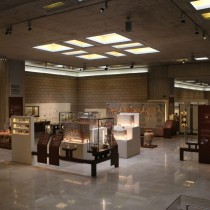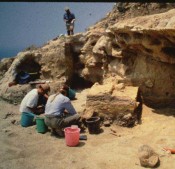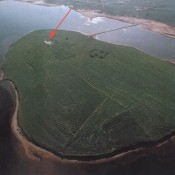Today’s museum of Thebes is the third to be built on this specific site. Since 1894, a small archaeological collection had been created in Thebes, housed in the then existing barracks next to the medieval tower. The first collection’s antiquities were gathered by the Archaeological Society at Athens with its prominent member P. Stamatakis, who had taken on the difficult task of saving them from antique smugglers, endemic at that time. In 1905, antiquities resulting from collections and first excavations were housed in the town’s Archaeological Museum, which was a small two storey building originating from the conversion of the barracks and erected at the expense of the Archaeological Society. The first exhibition was set up by Antonios Keramopoullos. A host of archaeologists had visited Thebes in the pre war, war and post war period until approximately 1950. The most distinguished among them was Christos Karouzos who left his mark with the outstanding first “Guide to the Museum of Thebes” and who had worked successfully to salvage the antiquities of the museum in the war years and the German Occupation.
Following Greece’s liberation, the town’s little old museum stayed shut for several years and then in 1950, it was decided that it be demolished and a new, bigger one to be erected in its place. The opening of the second museum took place on December 9th 1962, about three months after the death of Ioannis Threpsiades, who had worked enthusiastically for the new exhibition’s completion, almost up to the day he died. This second museum, its exhibition being slightly modified from time to time, functioned over a course of 45 years, up to its incorporation, in 2007, with today’s New Archaeological Museum of Thebes.
The building of the New Archaeological Museum of Thebes
The need for a modern museum, worthy of centuries old Boeotian history, led to modernizing the existing building and adding on an extension. The architect Michalis Souvatzidis (note 1) designed the new building to be incorporated with the old one. An inner atrium was a key element in the merging of the two buildings. The single building and the galleries, one on the inside surrounding the atrium, one as a raised corridor and three in the courtyard, create a varied and interesting whole. Moreover, they contribute to more than doubling the exhibition space which now covers 1,000 square meters on the inside, instead of the 613 sq. m. of the earlier one. Added to these are 1,390 sq. m. of semi outdoor exhibition space and 1,750 sq. m. outdoor space. The new building’s unique and impressive architecture also inspired the Thebes Museum logo.
The exhibition of the New Archaeological Museum of Thebes
The museology and museography study and that of upgrading the archaeological site were carried out between 2007 and 2010, as part of the Third Community Support Framework, overseen by the Directorate of Museums with the close collaboration of the jointly responsible Antiquity Ephorates of the Ministry of Culture (note 2). Between 2011 and 2015 theproject on the redisplaying of the exhibition was implemented with the collaboration of the jointly responsible Antiquity Ephorates of Boeotia.
A great number of employees worked during the lengthy preparation of the New Archaeological Museum of Thebes; included were those with fixed term or indefinite duration contracts from all specialties (note 3). This large project was completed with the successful cooperation and collection of data from other services and various institutions (note 4).
The scientific work carried out during this project was also especially significant, with new data resulting from recent excavations and publications. Also contributing to this was the collaboration of archaeologists and scholars of Boeotian antiquities (note 5).
Studies were carried out regarding the support of the antiquities and the arrangement of the showcases (note 6), specialized conservators saw to the conservation and restoration of exhibits such as wall paintings, mosaic floors, manuscripts and stone lions (note 7), data was collected from various institutions and we cooperated with several services such as the Directorate of Conservation, the Ephorate of Speleology, the Byzantine Museum of Athens, the Acropolis Museum et al. The above allowed those of the museum personnel involved to broaden their knowledge and acquire experience in many areas.
The museology study determined the museum’s interpretative angle and stressed the exhibition’s narrative and educational character that was supported both by the exhibits’ arrangement in space and the visual and digital material. The exhibition’s timeless character is an important factor, based on a non evaluative approach to the past. The museum features a new element; the coexistence of two archaeological sites in its surroundings, incorporated into the exhibition route.
Three dimensional interpretative material includes 3D models of archaeological sites and monuments, actual and drawn reconstructions as well as restorations. In this way, visitors can directly understand and interpret the exhibits.
The exhibition includes antiquities from earlier excavations and is enhanced to a great degree by new exhibits originating from excavations of recent years.
Some exhibit assemblages are, in fact, one of a kind in Greece and the world, such as the unique collection of cylinder seals from the “Treasure Room” [Δωμάτιο του Θησαυρού] of the Mycenaean palace of Thebes, brought from the East, the collection of lapis lazuli jewellery, stirrup amphorae used for commerce, with inscriptions in Linear B script, ceramic, painted larnakes from Tanagra, unique in mainland Greece.Other exhibits include a group of grave stelae made of dark Boeotian stone, with wonderful engraved figures of warriors in action on the battlefield, a few Kouroi from the sanctuary of Apollo on mount Ptoon and a group of porous funerary entablatures. Apart, however, from the monuments of prehistory and Greek antiquity, there is now a place in the museum for material remains from the Byzantine era and the subsequent centuries, throwing light on aspects of life in the city and the greater area, hitherto unknown.
Sections of the exhibition in the Thebes Museum
The exhibition is arranged in a total of 18 sections, 11 of which follow a basic chronological order, from the Stone Age period up to and including the formation of the Greek state (sections 3-14). Presented through the exhibits of the above sections are the history, culture, daily life, political and social evolution of Boeotia, a region with a particular historical significance, due to its geographical position and its geomorphologic structure that have acted as catalysts over the centuries.
Section 1: History of the museum and excavations in Boeotia
The history of the museum and of archaeological research in Boeotia is presented in the foyer (1), through archive documents, artifacts from early excavations and photographic material. Short films are also screened, related to the museum and excavations, work on the new exhibition and highlights from conservation work in the museum and the Medieval tower.
Section 2: Landscapes and myths of Boeotia
One of two special sections inserted in the general narrative is section 2 called “Landscapes and myths of Boeotia”, in which the visitor is informed about Boeotia’s geography, its natural surroundings and rich mythological past (Cadmus, the story of Oedipus, Hercules and Dionysus). Placed in the same section and along the wall, is the so called “flow of time”; a timeline structure where Boeotia’s most significant historical events are recorded. The section is completed by an interactive application, the digital timeline, as well as two videos on the “Landscapes of Boeotia” and “Myths of Boeotia”.
Section 15: The spiritual aura of Boeotia across the centuries
Section 15 is the second special, inserted section that runs through the elevated corridor/gallery surrounding the atrium. Its theme is “The spiritual aura of Boeotia across the centuries.”
In this section, the spiritual legacy of Boeotia to the global community is presented through old prints, copies of incunabula and an interactive digital screening of tributes to important historical personalities of Boeotian origin, such as Plutarch, Pindar, Corinna et al., to travellers and other exceptional people who were active in Boeotia from the 14th to the 19th century, or were inspired by this place as were 20th century photographers.
The section is also enhanced by a video about “The timeless significance of Copais.”
Specially mentioned is the contribution made to ancient drama by the Theban mythological cycle which inspired the tragic poets of the 5th century BC.
The presentation uses supervisory material such as texts and photographs (note 8), as well as archaeological finds related to the theatre (masks, figurines of actors et al.), while it includes the screening of a film with extracts from contemporary performances of ancient drama. The exhibition is enhanced by a contemporary theatre costume worn in a tragedy from the Theban cycle (note 9).
The sections arranged in chronological order, include, in brief, the following:
Section 3: Stone Age
Section 3 presents exhibits related to the first material finds in Boeotiafrom the dawn of civilization; the Palaeolithic (33000-6800 BC) and the Neolithic period (6800-3200 BC). These are displayed on two large exhibition surfaces, one for the great variety of its finds (tools, obsidian, figurines, pottery etc) and one for its supervisory material.
Section 4: BronzeAge
Section 4 concentrates on the Early and Middle Bronze Age (3200-1700 BC). It includes a great variety of exhibits, such as small figurines, tools and pottery. The birth of Mycenaean civilization is also presented.
Section 5: Mycenaean Period
Given the significance of Thebes during the Mycenaean period, it is obvious that Section 5 (1400-1200 BC) is one of the most important in the museum.The organization of the Mycenaean world in general is thoroughly presented here, as well as the organization of the palace of Thebes in particular.
Special reference is made to the clay tablets in Linear B script that are among the museum’s most important exhibits and which, depending on the information they give, are placed in a separate thematic subsection.
The various workshops that operated in areas of the palace make up a separate section, so as to clarify the special place held by it, the palace, in the social structure.
The funerary larnakes of Tanagra are also unique antiquities, clearly with Minoan influences, placed in the section’s centre. Moreover, included are reproductions of life size wall paintings from the citadels of Gla, Orchomenos and Thebes, as well as structural remains from buildings of that same period.
The section is also enhanced by a short video on Mycenaean architecture, as well as an interactive application about the scribe of Linear B.
The Sub-Mycenaean period, following the collapse of the palaces, takes up limited space and functions in combination with the previous period and as a link to the next. It includes pottery from graves of the period and a wall text.
Section 7: Proto-Geometric and Geometric period
Section 6 exhibits finds of the Proto-GeometricandGeometricperiod (1050-700 BC). The showcases display mainly pottery as well as weapons, jewellery and metal work objects, while a rich funerary assemblage from Kamilovrisi of Paralimni is exhibited in a low showcase.
The section is completed by an interactive application about the potter and vase painter of the Geometric period.
Section 7: Archaic period
Section 7 exhibits finds from the Archaic period (700-480 BC), which include the Kouroi statues that make up one of the most important groups of exhibits in the museum. For this reason they occupy the centre of the section.
Moreover, the section on Warfare is of particular interest, with the dominant historical event being the battle of Plataea; a symbol of unity between the Greeks, as well as the subsection presenting the so-called “Boeotian alphabet”. This section has a very generous number of exhibits.
Section 8: Classical period
In section 8, exhibits are displayed from the Classical period (479-323 BC), one of the richest eras both in terms of number and quality of finds, as in historical events. Finds include black Boeotian grave stelae, exhibits related to the battles of Tanagra and Leuctra, a large number of reliefs, everyday objects of excellent quality as well as two funerary assemblages with very significant and well preserved grave goods. The section is also supported with a video on the city during the Classical period.
Section 9: Hellenistic period
Section 9 includes exhibits related to the Hellenistic period (323-31 BC). Special reference is made to new forms of authority, Hellenistic kingdoms and the institution of the city, relations of Macedonians and Romans with Boeotia till the 1st century BC, the life of slaves as well as the organization of the Hellenistic house, supported with an interactive application.
Exhibits making up the section are varied: pottery, jewellery, sculptures, inscriptions, the well known figurines of the period, i.e. the so-called Tanagra figurines, as well as part of a painted floor depicting a flute player, winner in musical contests.
The section is also enhanced by a model of a “Macedonian type” monumental grave excavated in ancient Tanagra.
Section 10: Roman period
Section 10 includes the exhibits of the Roman period (31 BC-330 AD), the most important one being the statue of the emperor Hadrian. Apart from that, the section is made up of a great number of exhibits, highlighted by the glass utensils, a large bronze bathtub, standards for measuring liquids, statues, artifacts from the cult of eastern deities.
Particular prominence is given to one of the most recent excavation finds in the district. This is a grave stele with the painted portrait of the deceased, whose name was Theodoros (“ΘΕΟΔΩΡΟΣ”).
Section 11: Early Byzantine period
Section 11 includes the exhibits of the Proto-Byzantine era(324-565 AD). Its artifacts are mainly parts of sculptured architectural ornamentation and architectural members, but there is also a considerable number of utilitarian ceramic vases.
Byfarthe most important exhibit in this section and among the most significant in the museum is the 6.50×3.50m mosaic floor with personifications of the four months, which is incorporated in the subsection on mosaics of Boeotia and the manner of their construction.
Special reference is also made to the professions with which specific exhibits are related, such as the builder, the beekeeper, the potter et al.
The section’s rich supervisory material includes the projection on a large screen of images of mosaics in Boeotia, originating mainly from secular buildings, as well as an interactive application about the mosaic craftsman.
Section 12: Mid–Byzantine period
Section 12 includes the exhibits of the Mid-Byzantine times (mid-9th century-1204 AD). Special mention is made to the city of Thebes and other settlements contemporary to it, both regarding their organization and structure as well as daily life and commerce.
Administration is presented, the silk trade, Bishop Kalokteni’s works of infrastructure, as well as daily life, dress, ornamentation and the technique of glazing. On display are also wall paintings, sculpted members and decorative elements.
The section is completed by a video on the Byzantine city and closes with the Byzantine monuments of Thebes and Boeotia in general, in a specially designed area.
Section 13: Period of Western Rulers
Section 13 includes exhibits on the period ofWestern Rulers in Boeotia(1204-1460 AD), a particularly significant time for Thebes and its place in the Grecian world.
Administrative organization and defence are presented, while special mention is made of the Panakton as a representative example of a Frankish settlement. Matters of economics are also presented and matters related to trade and crafts. The section closes with exhibits related with daily life.
Section 14: Period of Ottoman Rule
Section 14, also the last in the exhibition’s timeless narrative, includes the exhibits related to the period of Turkish Rule in Boeotia(1460-1830 AD).
The new method of governing the region is presented, which had replaced the earlier one used by the Franks. Special mention is made of the Kazas (districts) of Thebes and Levadeia, as well as the daily life at that time.
A great number of everyday objects are displayed, such as ceramic utensils, swords, tobacco pipes, while effort is made to present Ottoman grave stelae in the way they would have been placed in Ottoman cemeteries.
However, neither the religious life of the Orthodox Christians is absent from this section, nor the flourishing of monumental painting with the School of Thebes.
Section 16: Prehistoric archaeological site
As part of the exhibition, it is easy to visit the important archaeological site discovered in the foundations of the building’s extension, also visible from inside the exhibition through a glass floor. The site includes successive phases of prehistory from 2500 up to and including 1400 BC.
The roofed archaeological site is accessible from the atrium gallery by an outside staircase. It includes an apsidal building surrounded by a high, solid enclosure both made of mud bricks and obviously belonging to a family that was quite affluent and possibly one of the most important in the settlement (circa 2500 BC).
After a sudden catastrophe in 2300-2200 BC, at least twelve people, men, women and children, were buried as a group in the ruins of the building, along the characteristic grave goods of the period. Subsequently all the region, inside and outside the monumental building, was sealed with a large mound made up of layers of mud bricks.
In the Middle Bronze Age (2000-1700 BC), the region of the mound was used as a cemetery with cist or pit graves, possibly in an effort to preserve relations with distant ancestors.
Several centuries later, in Mycenaean times (14thto 13th century BC), part of the fortification wall that surrounded the Kadmeia had its foundations built on that same spot, thus destroying part of the mound. At the archaeological site there is an interactive application with a touch screen that gives facts on the antiquities and lights up the related spots, as well as a 3D model with phases of the site’s use.
Section 17: Court yard
Exhibited in the colonnade of the court yard (section 17) are statues, inscribed bases, alters, votive and grave stelae in relief, sarcophagoi as well as architectural members. Regardless of their artistic quality, they enrich our knowledge on the history of ancient Boeotia, its public and private life as well as its art.
The funerary stone lions in the centre of the court yard are especially impressive. They were often placed on mass graves (polyandria), graves of eminent citizens and the pedestals of the Muses of Mount Elikon, which the people of Thespies had entrusted to their sanctuary in the valley by that name.
Inscriptions constitute a particular category, whose testimonies shed light on the public and private life of the Boeotians. Exhibited are inscriptions on the liberation of slaves, ones recording the winners in contests, even an inscription by the Emperor Hadrian, engraved on a marble pillar which was part of a public building. It is an epistle addressed to the people of Coronea, regarding land improvement works in Copais.
Section 18: Medieval tower of Saint Omer
It is the first time that the Frankish tower (section 18) in the museum courtyard can be visited. It is believed to have been built at the end of the 13th century by the nobleman Nicolas II de Saint Omer, to whose family half the city of Thebes had been given as a dowry by the rulers of the Duchy of Athens.
It is the best preserved part of Thebes’ medieval fortifications, with a rectangular ground plan and a height of 14 meters. Originally it had at least three storeys, of which the first and second survive today.
Recent works on supporting and restoring the monument brought to light significant archaeological data, while as part of this a short exhibition was put together, whose theme is both this building’s function and that of the towers scattered all over the countryside of Boeotia, landmarks in the region to this day.
At the end of the 19th century, the tower was used as a prison and on the ground floor walls are drawings by the inmates, in which they are counting their sentences that are unknown to us.
The Archaeological Museum of Thebes: A place both of education and inspiration
The main objective is to transform the Museum into a versatile organization with a broad range of activities, so as to respond to its educational and recreational role. Realizing educational programmes in a specially designed hall, also contributes to this, as well as loaning educational material and copies of ancient artifacts in the form of aesthetically pleasing museum kits for school groups.
The new museum of Thebes has been designed to be accessible to the disabled or visually impaired and provision has been made for special touch tours of selected exhibits. It satisfies the requirements of a varied public with different demands and can be regarded both as a complete learning experience and the good use of free time.
This original and dynamic new exhibition can play the part of a place of learning while also being uplifting, inspirational and intellectually liberating.
The Thebes museum now constitutes the main cultural hub of the town and a significant tourist attraction, playing an important role in the growth both of Thebes and the whole of Boeotia.
Moreover, a combined visit to the moveable excavation finds inside the museum and the archaeological remains in their natural surroundings, also contributes to the cultural awareness of the town’s inhabitants, reminding them of the multifaceted value of antiquities and the possibility of harmoniously co existing with them in the context of the fast rate of growth today.
Dr Alexandra Charami
Archaeologist, Director of the Ephorate of Antiquities of Boeotia
